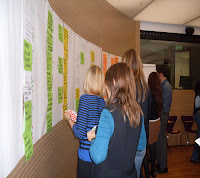 We are all concerned about climate change, and we are all aware of the impact of emissions on climate change. We know that continued emissions at or above current rates would cause further warming of the planet and cause many changes in the global climate system (e.g. increase risk of flooding and drought in certain areas). However, our emissions rather than decreasing are increasing; a trend that needs to be reversed urgently. That is why, the “UN system is collectively developing a climate-neutral approach for its premises and operations. The responsibility for the future lies in our hands. Let change begin at home” (foreword by the UN Secretary-General to “Moving Towards a Climate Neutral UN) and we also committed to play a proactive role in moving towards a climate neutral UN.
We are all concerned about climate change, and we are all aware of the impact of emissions on climate change. We know that continued emissions at or above current rates would cause further warming of the planet and cause many changes in the global climate system (e.g. increase risk of flooding and drought in certain areas). However, our emissions rather than decreasing are increasing; a trend that needs to be reversed urgently. That is why, the “UN system is collectively developing a climate-neutral approach for its premises and operations. The responsibility for the future lies in our hands. Let change begin at home” (foreword by the UN Secretary-General to “Moving Towards a Climate Neutral UN) and we also committed to play a proactive role in moving towards a climate neutral UN.The workshop held on 8 November was a great opportunity to:
 • be briefed on what we have done thus far to reduce emissions
• be briefed on what we have done thus far to reduce emissions• understand why we need to develop and implement an IFAD emission reduction plan
• generate ideas that can impact on emissions reduction
• assess the viability of the ideas proposed during the workshop.
The good news is that a number of concrete actions with a view to reduce emissions have already been taken, some examples:
• green building certification award at the Gold level in recognition of IFAD’s state-of-art HQ
• reduction in consumption of electricity from 2009 to 2010
• reduced use of plastic water bottles by installing drinking water fountains
• shuttle bus service from/to metro station to discourage the use of private cars
• reduction in paper consumption by implementing double-sided printing
• implementation of parking fees to encourage the use of public transportation
• video-conference facilities to reduce the number of travels to attend meetings.
Much has been done, but more needs to be done. Elina Virtanen and Pasi Rinne, the experts from Gaia Innovative Solutions for Sustainability, presented the baseline figures for reporting on IFAD’s emissions. Did you know that IFAD total emissions in 2009 were equivalent to 5089 tCO2 ?

Did you know that from 2009 to 2010 IFAD emissions have increased by 10 % and that air travel emissions have increased by 17 %?

Did you know that in 2009 IFAD emissions per staff were equal to 5,7 tCO2 ; far from a sustainable level! Based on IPCC estimates, in 2050 the emissions per person should be 2.8 t CO2.
While it's true that IFAD compared to other UN organizations has lower emissions, numbers still show how far we are from a sustainable emission level for our planet. Figures tell us we have to start planning today to achieve tomorrow’s targets. IFAD’s emission reduction plan is the tool we will be using to:
• define where we are today in terms of emissions caused
• identify the required actions to reduce emissions
• indicate realistic objectives and timeline.
We, as participants of the workshop, had the chance to “scout for ” ideas on how to further reduce emissions in the following areas:
• facility
• paper consumption and waste
• ICT (energy efficiency and enabling virtual meetings)
• travel
 • commuting
• commuting • procurement
• others (thinking out of the box)
It’s amazing how many ideas were “sticked” in about 30 minutes. I was also impressed by the number of “green” stickers that we used to mark the proposed actions as “realistic” and “viable” , in other words, actions that could be included in IFAD’s emission reduction plan.
 The ones I liked the most?
The ones I liked the most? Adopt a sustainable procurement policy that takes into account the environmental impact of products and servicesAll staff teleworking 1 day a week
"Think big" and have a low-carbon cafeteria
Adopt a green travel policy
 As Matthias Meyerhans, director ADM, pointed out “we have to change our habits if we intend to seriously pursue climate neutrality …..only if we as staff member and environmental conscious citizens are willing to change, significant emissions reduction can be achieved”
As Matthias Meyerhans, director ADM, pointed out “we have to change our habits if we intend to seriously pursue climate neutrality …..only if we as staff member and environmental conscious citizens are willing to change, significant emissions reduction can be achieved” IFAD’s emission reduction plan is about us, about the way we will be working in the coming years. If you did not have the chance to participate in the workshop and are interested in knowing more about the actions proposed, you can still contribute by sharing your ideas through yammer
“Our programs focus increasingly on adaptation to climate change and it is right that we look for measures to reduce emissions in our own activities.”
Elwyn Grainger-Jones, Director ECD





0 comments:
Post a Comment